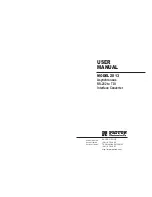
HV100 Series High Performance Current Vector Inverter
126
Chapter VIII EMC (Electromagnetic Compatibility)
8.1 Definitions
Electromagnetic compatibility (EMC) refers to the ability of electrical equipment to operate in an electromagnetic
interference environment without interfering with the electromagnetic environment and to stably realize its functions.
8.2 Introduction to EMC Standards
According to the requirements of national standard GB/T12668.3, the inverter needs to meet the requirements of
electromagnetic interference and anti-electromagnetic interference.
Our existing products comply with the latest international standard: I e c/e n 61800-3: 2004 (adjustable speed electrical
power drive systems part 3: EMC requirements and specific test methods), which is equivalent to the national standard
GB/T12668.3.
IEC/EN61800-3 mainly investigates inverters from two aspects: electromagnetic interference and anti-electromagnetic
interference. Electromagnetic interference mainly tests radiation interference, conduction interference and harmonic
interference of inverters (this requirement is applicable to inverters used for civil use). Anti-electromagnetic interference
mainly affects the transmission immunity, radiation immunity, surge immunity, fast burst immunity, ESD immunity and
power supply low-frequency end immunity (specific test items include:
1. Immunity test of input voltage sag, interruption and change;
2. Commutation notch immunity test;
3. Harmonic input immunity test;
4. Input frequency change test;
5. Input voltage imbalance test;
6. Input voltage fluctuation test). According to the strict requirements of IEC/EN61800-3, our products are installed and
used according to the instructions shown in 7.3, and will have good electromagnetic compatibility in general industrial
environment.
8.3 EMC guidance
8.3.1 Influence of harmonics:
High-order harmonics of power supply will damage the inverter. Therefore, it is suggested to install AC input reactors
in some places with poor power grid quality.
8.3.2 Electromagnetic interference and installation precautions:
There are two kinds of electromagnetic interference, one is the interference of the electromagnetic noise of the
surrounding environment to the inverter, and the other is the interference of the inverter to the surrounding equipment.
Precautions for installation
:
1) the grounding wires of inverters and other electrical products shall be well grounded;
2) The power input and output lines and weak current signal lines (such as control lines) of the inverter should not be
arranged in parallel as far as possible, but should be arranged vertically when there are pieces;
3) It is recommended to use shielded cable or steel pipe to shield the power line for the output power line of the inverter,
and the shielding layer should be reliably grounded. For the lead of the interfered equipment, it is recommended to use
twisted shielded control line and reliably ground the shielding layer;
4) If the length of motor cable exceeds 100m, it is required to install output filter or reactor.
8.3.3 Treatment method of interference of peripheral electromagnetic equipment to
inverter:
Generally, the electromagnetic influence on the inverter is caused by a large number of relays, contactors or
electromagnetic brakes installed near the inverter. When the inverter malfunctions due to interference, the following
measures are recommended:
1) Surge suppressors are installed on devices that generate interference;
2) Install a filter at the input end of the inverter, refer to 7.3.6 for specific operation;
3) The leads of control signal lines and detection lines of inverters shall be shielded cables and the shielding layer shall
be grounded reliably.
8.3.4 Measures to deal with interference caused by inverter to peripheral
equipment:
There are two kinds of noise in this part: one is the radiation interference of inverter, and the other is the conduction
interference of inverter. These two kinds of interference make peripheral electrical equipment suffer electromagnetic or















































